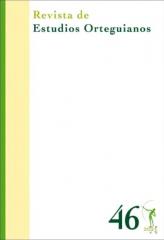Ludendo vivere. Filosofía y juego entre Ortega y Gasset y Huizinga
DOI:
https://doi.org/10.63487/reo.74Keywords:
Ortega y Gasset, Huizinga, philosophy, play, sport, Homo ludens, ludic reasonAbstract
This article investigates the biographical and theoretical relationship between Ortega y Gasset and Huizinga in relation to homo ludens and the playful nature of life and philosophy. By tracing Ortega’s thinking on play and sport from the 1920s to his maturity, and the traces left by Huizinga’s Homo ludens from 1938 onwards, the article attempts to delve deeper into the playful philosophy of the late Ortega.
Downloads
References
BENJAMIN, W. (1972-1991): Über das mimetische Vermögen (1933), en Gesammelte Schriften, 7 vols., edición de R. Tiedemann y H. Schweppenhäuser. Fráncfort del Meno: Suhrkamp, vol. II, pp. 210-213.
CAILLOIS, R. (1967): Les jeux et les hommes: le masque et le vertige. París: Gallimard.
CEREZO GALÁN, P. (1984): La voluntad de aventura. Barcelona: Ariel.
CONILL SANCHO, J. (2019): “El sentido deportivo de la vida en la hermenéutica raciovitalista de Ortega y Gasset”, Pensamiento: Revista de investigación e información filosófica, 75 (286 Extra), pp. 1061-1078.
CRUZ CRUZ, J. (1970): “Entre el ocio y el juego: los radicales de la cultura”, Anuario filosófico, 3/1, pp. 9-92.
ECO, U. (1973): “«Homo ludens» oggi”, introducción en J. HUIZINGA, Homo ludens, traducción italiana de C. Van Schendel. Turín: Einaudi, pp. VII-XXVII.
FINK, E. (1957): Oase des Glücks. Gedanken zu einer Ontologie des Spiels. Friburgo – Múnich: Alber.
FINK, E. (1960): Spiel als Weltsymbol. Stuttgart: Kohlhammer.
FINK, E. (1979): Das Spiel als fundamentaler Zug unseres Daseins, en Grundphänomene des menschlichen Daseins. Edición de E. Schütz y F.-A. Schwarz. Friburgo – Múnich: Alber.
GUTIÉRREZ POZO, A. (2000): “Metáfora e ironía, claves de la razón vital”, Daimon. Revista de filosofía, 20, pp. 107-123.
HUIZINGA, J. (1939): Homo ludens. Versuch einer Bestimmung des Spielelementes der Kultur. Ámsterdam: Pantheon Akademische Verlagsanstalt.
HUIZINGA, J. (1943): Homo ludens. Lisboa: Editorial Azar.
HUIZINGA, J. (1989-1991): Briefwisseling, 3 vols. Utrecht: Veen.
JAEGER, W. (1973): Paideia. Die Formung des griechischen Menschen. Berlín – Nueva York: De Gruyter.
KANT, I. (1910-): Kritik der Urteilskraft, en Gesammelte Schriften, 22 vols. Berlín: De Gruyter, vol. V.
LLERA ESTEBAN, L. de (2000): “Ortega, ¿filósofo mondain o metafísico de lo lúdico?”, en G. MORELLI (ed.): Ludus. Cine, arte y deporte en la literatura española de vanguardia. Valencia: Pre-Textos, pp. 49-66.
MARÍAS, J. (1960): Circunstancia y vocación I. Madrid: Revista de Occidente.
MARÍAS, J. (1971): Acerca de Ortega. Madrid: Espasa-Calpe.
ORRINGER, N. R. (1976): “Life as shipwreck or as sport in Ortega y Gasset?”, Romance Notes, 17/1, pp. 70-75.
ORRINGER, N. R. (2009): “Ortega, o la aurora del filosofar visto como deporte”, en M. GARRIDO, et. al. (eds.): El legado filosófico español e hispanoamericano del siglo XX. Madrid: Cátedra, pp. 233-268.
ORTEGA Y GASSET, J. (1994): Epílogo… Notas de trabajo. Edición de José Luis Molinuevo. Madrid: Alianza Editorial.
ORTEGA Y GASSET, J. (2004-2010): Obras completas, 10 volúmenes. Madrid: Fundación José Ortega y Gasset / Taurus.
PELLICANI, L. (2005): “Ortega y el «homo ludens»”, Revista de Occidente, 288, pp. 128-139.
PIEPER, J. (2000): Obras. Escritos sobre el concepto de filosofía. Vol. III. Madrid: Ediciones Encuentro.
SALAS, J. de (1997): “La metáfora en Ortega y Nietzsche”, en A. DOMÍNGUEZ y J. MUÑOZ (coords.): El primado de la vida. (Cultura, estética y política en Ortega y Gasset). Cuenca: Ediciones de la Universidad de Castilla-La Mancha, pp. 155-168.
TOYOHIRA, T. (2020): “El concepto de «club» en Ortega y Huizinga”, Ágora. Papeles de filosofía, 39/2, pp. 213-223.
VIDAL-NAQUET, P. (1986): “Chasse et sacrifice dans l’Orestie d’Eschyle”, en J.-P. VERNANT y P. VIDAL- NAQUET, Mythe et tragédie en Grèce ancienne. Vol. 1. París: La Découverte, pp. 133-158.





